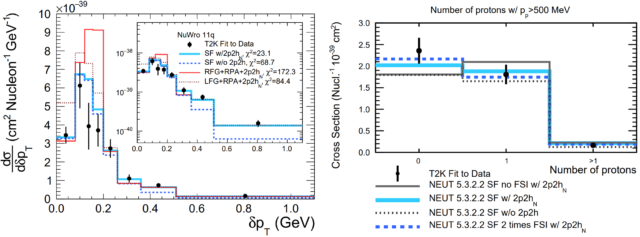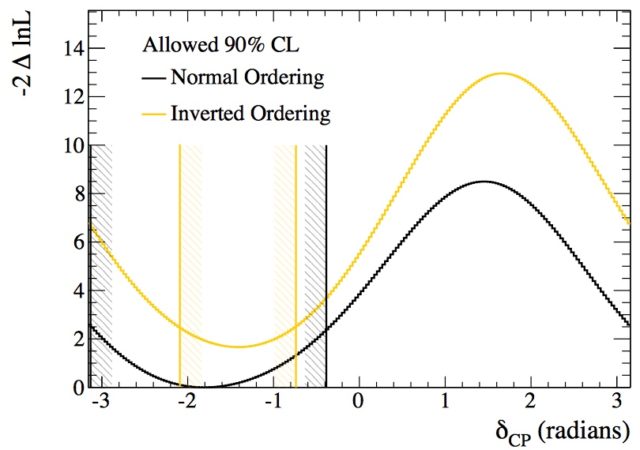Measurement of muon- antineutrino and neutrino charged-current inclusive cross sections and their ratio with the T2K off-axis near detector
We report a measurement of cross section σ(νμ+nucleus→μ-+X) and the first measurements of the cross section σ(ν¯μ+nucleus→μ++X) and their ratio R(σ(ν¯)σ(ν)) at (anti) neutrino energies below 1.5 GeV. We determine the single momentum bin cross section measurements, averaged over the T2K ν¯/ν-flux, for the detector target material (mainly carbon, oxygen, hydrogen and copper) with phase space restricted laboratory frame kinematics of θμ<32° and pμ>500 MeV/c. The results are σ(ν¯)=(0.900±0.029(stat)±0.088(syst))×10-39 and σ(ν)=(2.41±0.022(stat)±0.231(syst))×10-39 in units of cm2/nucleon and R(σ(ν¯)σ(ν))=0.373±0.012(stat)±0.015(syst).
Characterisation of nuclear effects in neutrino scattering with a measurement of final-state kinematics (2018)

Updated measurements of muon neutrino and antineutrino disappearance

Top panels show the reconstructed energy distribution of the 135 far detector νμ-CCQE candidate events (left) and 66 ν̅μ-CCQE candidate events (right), with predicted spectra for best fit and no oscillation cases. Bottom panels show the ratio to unoscillated predictions.
Measurement of Coherent π+ Production in Low Energy Neutrino-Carbon Scattering
We report the first measurement of the flux-averaged cross section for charged current coherent π+ production on carbon for neutrino energies less than 1.5 GeV, and with a restriction on the final state phase space volume in the T2K near detector, ND280. Comparisons are made with predictions from the Rein-Sehgal coherent production model and the model by Alvarez-Ruso et al., the latter representing the first implementation of an instance of the new class of microscopic coherent models in a neutrino interaction Monte Carlo event generator. We observe a clear event excess above background, disagreeing with the null results reported by K2K and SciBooNE in a similar neutrino energy region. The measured flux-averaged cross sections are below those predicted by both the Rein-Sehgal and Alvarez-Ruso et al. models.
First combined analysis of neutrino and antineutrino oscillations at T2K

Measurement of inclusive double-differential νμ charged-current cross section with improved acceptance

First measurement of the νμ charged-current cross section without pions in the final state on a water target
arXiv:1708.06771 [hep-ex], Phys.Rev. D97 (2018) no.1, 012001. The data release for this paper is here.

Measurement of neutrino and antineutrino oscillations by the T2K experiment, including a new additional sample of electron neutrino interactions in the far detector
The T2K experiment reports an updated analysis of neutrino and antineutrino oscillations in appearance and disappearance channels. A sample of electron neutrino candidates at Super-Kamiokande in which a pion decay has been tagged is added to the four single-ring samples used in previous T2K oscillation analyses. Through combined analyses of these five samples, simultaneous measurements of four oscillation parameters, |Δm322|, sin2θ23, sin2θ13, and δCP and of the mass ordering are made. A set of studies of simulated data indicates that the sensitivity to the oscillation parameters is not limited by neutrino interaction model uncertainty. Multiple oscillation analyses are performed, and frequentist and Bayesian intervals are presented for combinations of the oscillation parameters with and without the inclusion of reactor constraints on sin2θ13. When combined with reactor measurements, the hypothesis of CP conservation (δCP=0 or π) is excluded at 90% confidence level. The 90% confidence region for δCP is [-2.95,-0.44] ([-1.47,-1.27]) for normal (inverted) ordering. The central values and 68% confidence intervals for the other oscillation parameters for normal (inverted) ordering are Δm322=2.54±0.08(2.51±0.08)×10−3 eV2/c4 and sin2θ23=0.55-0.09+0.05 (0.55-0.08+0.05), compatible with maximal mixing. In the Bayesian analysis, the data weakly prefer normal ordering (Bayes factor 3.7) and the upper octant for sin2θ23 (Bayes factor 2.4).
Search for Lorentz and CPT violation using sidereal time dependence of neutrino flavor transitions over a short baseline
A class of extensions of the Standard Model allows Lorentz and CPT violations, which can be identified by the observation of sidereal modulations in the neutrino interaction rate. A search for such modulations was performed using the T2K on-axis near detector. Two complementary methods were used in this study, both of which resulted in no evidence of a signal. Limits on associated Lorentz and CPT-violating terms from the Standard Model extension have been derived by taking into account their correlations in this model for the first time. These results imply such symmetry violations are suppressed by a factor of more than 1020 at the GeV scale.
First Measurement of the Muon Neutrino Charged Current Single Pion Production Cross Section on Water with the T2K Near Detector

The T2K off-axis near detector, ND280, is used to make the first differential cross section measurements of muon neutrino charged current single positive pion production on a water target at energies ∼0.8~GeV. The differential measurements are presented as a function of muon and pion kinematics, in the restricted phase-space defined by pπ+>200MeV/c, pμ− >200MeV/c, cosθπ+ >0.3 and cosθμ− >0.3. The total flux integrated νμ charged current single positive pion production cross section on water in the restricted phase-space is measured to be ⟨σ⟩ϕ=4.25±0.48 (stat)±1.56 (syst)×10−40 cm2/nucleon. The total cross section is consistent with the NEUT prediction (5.03×10−40 cm2/nucleon) and 2σ lower than the GENIE prediction (7.68×10−40 cm2/nucleon). The differential cross sections are in good agreement with the NEUT generator. The GENIE simulation reproduces well the shapes of the distributions, but over-estimates the overall cross section normalization.



